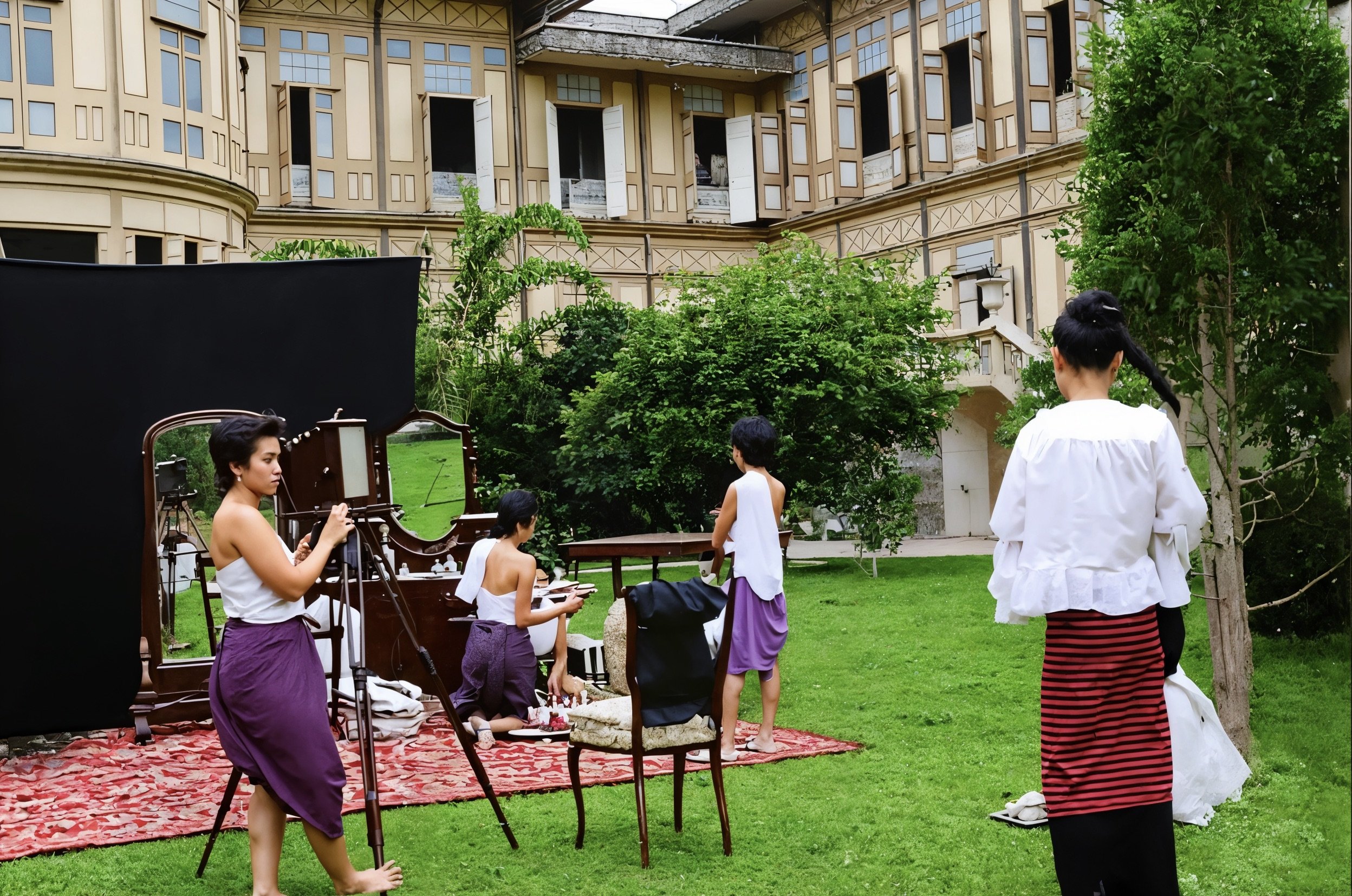งานบูรณะพระรูปของพระราชชายา เจ้าดารารัศมี ณ พระที่นั่งวิมานเมฆ (พ.ศ. 2448)
งานบูรณะพระรูปของพระราชชายา เจ้าดารารัศมี ณ พระที่นั่งวิมานเมฆ (พ.ศ. 2448)
จากภาพถ่ายต้นฉบับโดยเจ้าจอมเอิบ บุนนาค ดำเนินการบูรณะและลงสีด้วยเทคโนโลยี AI
ผลงานชุดนี้ประกอบด้วยพระรูปจำนวน 8 ภาพ ที่ได้รับการลงสีและบูรณะรายละเอียดด้วยเทคโนโลยี AI ควบคู่กับภาพต้นฉบับขาวดำและภาพเบื้องหลังการถ่ายทำหายาก ซึ่งถ่ายไว้เมื่อ พ.ศ. 2448 ณ พระที่นั่งวิมานเมฆ พระราชวังดุสิต กรุงเทพมหานคร โดยฝีมือของเจ้าจอมเอิบ บุนนาค ในสมัยรัชกาลที่ 5 ตอนปลาย เจ้าจอมเอิบเป็นสตรีเพียงไม่กี่คนที่มีบทบาทในด้านการถ่ายรูปในยุคที่วิชาชีพช่างภาพส่วนมากเป็นผู้ชาย ภาพถ่ายของเจ้าจอมเอิบจึงเป็นทั้งผลงานศิลปะและหลักฐานทางประวัติศาสตร์ที่บันทึกภาพสตรีในราชสำนักด้วยสายตาและมุมมองที่ต่างไปจากมุมมองของช่างภาพผู้ชาย
การถ่ายภาพในครั้งนั้นจัดฉากขึ้นกลางแจ้งให้คล้ายกับห้องแต่งตัวแบบตะวันตกในยุควิกตอเรีย ประกอบด้วยโต๊ะเครื่องแป้ง กระจกเงา และพรม ซึ่งสะท้อนแนวคิดแบบ “สตูดิโอจำลอง” ตามแบบฉบับภาพถ่ายชั้นสูงในปลายคริสต์ศตวรรษที่ 19 ที่นิยมสร้างฉาก “ห้องส่วนตัวของสตรี” (lady’s boudoir) เพื่อแสดงภาพผู้หญิงในห้วงขณะอันเป็นส่วนตัวและงดงาม ภาพที่เจ้าดารารัศมีทรงปล่อยพระเกศายาวในบริบทเช่นนี้จึงมีความหมายเชิงสัญลักษณ์หลายระดับ ทั้งความเป็นอิสตรี ความสงบและความสวยงามงาม รวมไปถึงความภาคภูมิใจในอัตลักษณ์ชาติพันธุ์ล้านนา โดยเฉพาะอย่างยิ่งเมื่อพิจารณาว่าในภาษาทางศิลปะของภาพถ่ายวิกตอเรีย “เส้นผม” มักถูกตีความเป็นสัญลักษณ์ของความงาม ความทรงจำ และอัตลักษณ์เฉพาะตน
ผลงานชุดนี้เป็นการต่อยอดจากคอลเลกชันที่ผมเคยสร้างารรค์ทำปีที่แล้ว อย่างไรก็ตาม ด้วยความก้าวหน้าของเทคโนโลยี AI ในปัจจุบัน ผลงานชุดนี้จึงมีความคมชัด ละเอียด และมีมิติของแสงและสีที่สมจริงยิ่งขึ้น การใช้เทคนิคการลงสีและบูรณะในระดับความละเอียดสูง ทำให้ทุกท่านสามารถสัมผัสภาพถ่ายเก่าเหล่านี้ได้อย่างสดใสและใกล้ชิดราวกับเป็นภาพร่วมสมัย
กระนั้นก็ตาม ผลงานเหล่านี้มิใช่เพียงแค่การจำลองทางเทคนิค หากแต่เป็นการตีความเชิงศิลปะอย่างจงใจ ภาพต้นฉบับมีลักษณะพระพักตร์ที่หลากหลายแตกต่างกัน ผมจึงเลือกใช้แบบพระพักตร์เดียวกันในทุกภาพ เพื่อให้เกิดความต่อเนื่องทางอารมณ์และการสื่อความรู้สึกของพระราชชายาอย่างเป็นเอกภาพ อันสะท้อนถึงพระจริยวัตร ความสง่างาม และความเงียบขรึมของพระองค์ในฐานะสตรีผู้เป็นสะพานเชื่อมระหว่างสองวัฒนธรรม
ในสายตาของผู้คนในกรุงเทพฯ เจ้าดารารัศมีทรงเป็น "เจ้าต่างเมือง" หรือ "เจ้าจากเชียงใหม่" ที่มีความงามอันแตกต่างออกไป ขณะสตรีในราชสำนักสยามตัดผมสั้นทรงดอกกระทุ่มและนุ่งโจงกระเบนตามกระแสพระราชนิยม เจ้าดารารัศมีกลับทรงเลือกที่จะสืบทอดขนบล้านนาโดยการไว้ผมยาวและนุ่งผ้าซิ่นตลอดพระชนม์ชีพ การแต่งพระองค์และบุคลิกที่เรียบขรึมของพระองค์อาจทำให้หลายคนมองว่า "แปลกแยก" หรือ "ลึกลับ" หากแท้จริงแล้ว ภาพเหล่านี้เผยให้เห็นถึงหญิงสาวผู้เปี่ยมด้วยความมั่นคงทางจิตใจและหยัดยืนบนรากวัฒนธรรมของตนอย่างแน่วแน่
การใช้กระจกและโต๊ะเครื่องแป้งในภาพ มิได้เป็นเพียงองค์ประกอบตกแต่ง แต่ยังสื่อถึงการ “สะท้อน” ทั้งในเชิงสัญลักษณ์และเชิงวัฒนธรรม ภาพเหล่านี้เชื้อเชิญให้ผู้ชมพินิจพระราชชายาในฐานะบุคคลที่มีเจตจำนง มิใช่เพียงวัตถุแห่งการชื่นชมในความงาม หากแต่เป็น “ตัวแทนแห่งล้านนา” ที่ทรงดำรงคุณค่าของตนไว้ท่ามกลางราชสำนักสยามซึ่งกำลังเคลื่อนไปตามแนวคิดสมัยใหม่
ด้วยการผสานเทคโนโลยี AI เข้ากับบริบททางประวัติศาสตร์และการออกแบบเชิงศิลป์ คอลเลกชันนี้มิได้เป็นเพียงการอนุรักษ์ภาพถ่ายโบราณ แต่ยังเป็นการตีความใหม่ผ่านสายตาร่วมสมัย เพื่อเฉลิมพระเกียรติสตรีผู้มีบทบาทสำคัญในการเชื่อมโยงวัฒนธรรมล้านนาและสยามในช่วงหัวเลี้ยวหัวต่อของประวัติศาสตร์
Restored Portraits of Princess Dara Rasami at Vimanmek Mansion (1905)
Original photographs by Chao Chom Eab Bunnag, digitally colourised and artistically restored with AI
This collection features eight digitally enhanced portraits of Princess Dara Rasami, alongside original black-and-white photographs and rare behind-the-scenes documentation of the 1905 photoshoot at Vimanmek Mansion, Dusit Palace, Bangkok. The session was orchestrated by Chao Chom Eab Bunnag, a royal consort and one of the few women to work behind the camera in an era when photography was overwhelmingly male-dominated. Her work bridges the gap between courtly duty and artistic authorship, offering a sensitive yet modern visual record of royal women.
The shoot was staged in an open-air setting, carefully constructed to emulate a Western-style boudoir, complete with a dressing table, mirror, and carpet. This studio-like arrangement reflects the influence of Victorian photographic traditions, particularly the “lady’s boudoir” genre, which often portrayed women in private, reflective moments. In this context, the images of Princess Dara Rasami letting down her long Lanna-style hair take on layered significance—evoking both femininity and cultural pride. In Victorian visual language, hair was often linked to sensuality and identity; here, it serves as an assertion of ethnic heritage.
This project builds upon a similar series I produced last year. Thanks to the advancement of AI technology, the current collection presents far greater clarity, detail, and tonal precision. The use of high-resolution colourisation techniques allows the viewer to connect with these century-old images in a new, immediate way. However, these images are not purely technical reproductions—they are also artistic interpretations. While the original portraits showed subtle inconsistencies in facial expressions and features, I have chosen to apply a unified likeness to Princess Dara Rasami across the series. This deliberate coherence helps convey her presence with emotional continuity, reflecting both her dignity and the narrative I aim to tell.
Princess Dara Rasami was a foreign princess in the eyes of many in the Bangkok court. As a royal from Chiang Mai, she embodied traditions and aesthetics that stood apart from the emerging modern ideals of the Siamese capital. While Bangkok noblewomen adopted short hairstyles and jong kraben (court trousers), Dara Rasami remained steadfast in her Lanna identity—wearing the pha sin (tube skirt) and keeping her hair long. Her graceful appearance and quiet determination led some to view her as exotic, even distant, yet these photographs suggest a woman deeply grounded in cultural integrity.
The inclusion of mirrors and grooming elements in the setting serves not only as artistic props but also as metaphors for reflection—both personal and political. They invite us to see Dara Rasami not as a passive subject, but as a conscious bridge between cultures, carrying the legacy of Lanna into the heart of Siam’s modernising monarchy.
By fusing AI technology with historical narrative and artistic intent, this collection aims to revive, reinterpret, and honour one of the most visually fascinating figures in early 20th-century Siamese history.
#aifashionlab #AI #aiartist #aiart #aifashion #aifashiondesign #aifashionstyling #aifashiondesigner #fashion #fashionhistory #historyoffashion #fashionstyling #fashionphotography #digitalfashion #digitalfashiondesign #digitalcostumedesign #digitaldesign #digitalaiart #ThaiFashionHistory #ThaiFashionAI

























